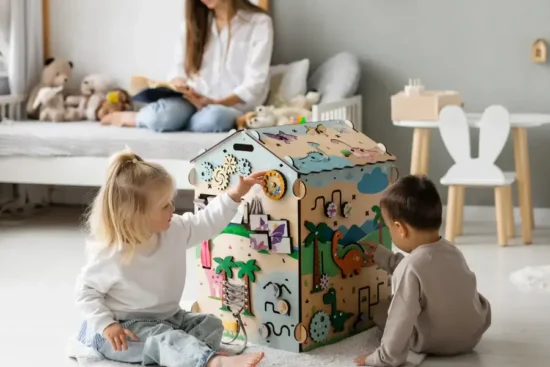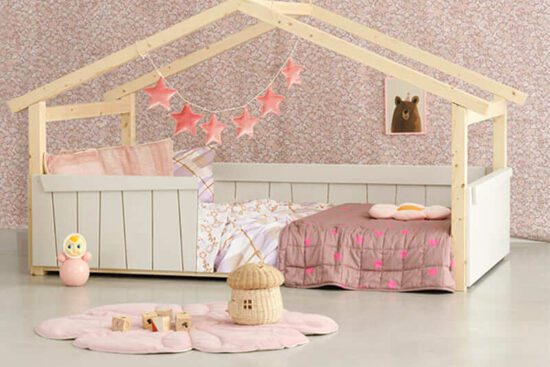Ein Lernturm, auch bekannt als Küchenhelfer oder Lernhocker, ist eine Art Möbelstück, das speziell für Kleinkinder entwickelt wurde, um ihnen mehr Unabhängigkeit und Teilnahme in der Küche oder anderen Aktivitäten zu ermöglichen. Der Lernturm ist in der Regel ein sicherer, stabiler Hocker oder eine Plattform mit Geländern oder einer Umrandung, um das Kind zu schützen. Der Zweck besteht darin, dem Kind zu erlauben, an erhöhten Oberflächen wie Arbeitsplatten teilzunehmen, um beim Kochen, Backen oder anderen Aktivitäten in der Küche behilflich zu sein.
Der Lernturm ermöglicht es dem Kind, auf Augenhöhe mit Erwachsenen zu sein und so besser an gemeinsamen Aktivitäten teilzunehmen. Es fördert die Unabhängigkeit, das Lernen und die motorischen Fähigkeiten, da das Kind selbstständig auf den Turm klettern und wieder heruntersteigen kann. Der Lernturm ist oft höhenverstellbar, um sich an das Wachstum des Kindes anzupassen.
Es ist wichtig zu betonen, dass bei der Verwendung eines Lernturms die Sicherheit immer an erster Stelle steht. Eltern oder Betreuer sollten sicherstellen, dass der Lernturm stabil ist und dass das Kind unter Aufsicht steht, insbesondere wenn es sich in der Nähe von heißen Oberflächen oder scharfen Gegenständen befindet.
Ab welchem Alter kann ein Lernturm genutzt werden?
Der optimale Zeitpunkt, ab dem ein Kind einen Lernturm nutzen kann, hängt von der individuellen Entwicklung des Kindes ab. In der Regel beginnen Kinder im Alter von etwa 18 Monaten bis 2 Jahren, ihre motorischen Fähigkeiten zu entwickeln und eine gewisse Unabhängigkeit zu zeigen. Dies ist oft eine geeignete Zeit, um mit einem Lernturm zu beginnen.
Es ist jedoch wichtig zu beachten, dass jedes Kind unterschiedlich ist, und einige Kinder entwickeln ihre Fähigkeiten schneller oder langsamer als andere. Bevor du einem Kind den Zugang zu einem Lernturm ermöglichst, solltest du sicherstellen, dass es in der Lage ist, sicher auf den Turm zu steigen und herunterzuklettern, ohne Hilfe zu benötigen. Die Fähigkeit zur Selbstregulation und das Verständnis für grundlegende Sicherheitsanweisungen sind ebenfalls wichtig.
Welche Arten eines Lernturms gibt es?
Es gibt verschiedene Arten von Lerntürmen, und ihre Designs können variieren. Im Allgemeinen können Lerntürme in zwei Hauptkategorien unterteilt werden: feste Lerntürme und klappbare oder zusammenklappbare Lerntürme. Hier sind einige gängige Arten von Lerntürmen:
- Fester Lernturm
Ein fester Lernturm ist ein stabil gebautes Möbelstück, das in der Regel aus Holz oder anderen robusten Materialien besteht. Er hat oft eine Plattform, auf der das Kind stehen kann, und Sicherheitsvorrichtungen wie Geländer, um das Kind zu schützen.
Feste Lerntürme sind oft höhenverstellbar, um sie an das Wachstum des Kindes anzupassen.
- Klappbarer oder zusammenklappbarer Lernturm:
Diese Art von Lernturm kann zusammengeklappt oder zerlegt werden, was sie besonders platzsparend macht. Sie sind oft leichter und einfacher zu transportieren als feste Lerntürme.
- DIY-Lernturm
Viele Eltern entscheiden sich dafür, ihre eigenen Lerntürme zu bauen, entweder aus Gründen der Personalisierung oder um Kosten zu sparen.
DIY-Lerntürme können aus Holz oder anderen Materialien hergestellt werden und können an die Bedürfnisse und den Stil der Familie angepasst werden.
- Multifunktionale Lerntürme
Einige Lerntürme sind so konzipiert, dass sie mehrere Funktionen erfüllen können. Zum Beispiel können sie in einen Tisch oder Stuhl umgewandelt, und mit Rutschen erweitert werden
Worauf muss ich beim Kauf eines Lernturms achten?
Beim Kauf oder der Nutzung eines Lernturms für dein Kind solltest du auf verschiedene Aspekte achten, um die Sicherheit und Funktionalität zu gewährleisten. Hier sind einige wichtige Punkte, auf die du bei einem Lernturm achten solltest:
- Stabilität und Material:
Stelle sicher, dass der Lernturm stabil und sicher ist. Er sollte aus hochwertigen Materialien hergestellt sein, die den Belastungen standhalten.
Holz ist ein häufig verwendetes Material, aber stelle sicher, dass es glatt geschliffen ist, um Verletzungen durch Splitter zu vermeiden.
- Sicherheitsvorkehrungen
Überprüfe, ob der Lernturm Sicherheitsvorkehrungen wie ein Geländer oder eine Umrandung hat, um zu verhindern, dass dein Kind herunterfällt.
Achte darauf, dass alle Kanten abgerundet und keine scharfen Ecken vorhanden sind.
- Höhenverstellbarkeit
Viele Lerntürme sind höhenverstellbar, um sie an das Wachstum deines Kindes anzupassen. Stelle sicher, dass die Höhenverstellung einfach und sicher ist.
- Tragfähigkeit
Achte auf die maximale Tragfähigkeit des Lernturms, um sicherzustellen, dass er das Gewicht deines Kindes sicher tragen kann.
- Pflegeleichtigkeit
Überprüfe, wie einfach der Lernturm zu reinigen ist. Kinder können beim Kochen oder Basteln unordentlich werden, daher ist es wichtig, dass der Turm leicht zu säubern ist.
- Montage und Demontage:
Falls du einen zusammenklappbaren oder montierbaren Lernturm wählen, stelle sicher, dass die Montage und Demontage einfach und sicher durchgeführt werden kann.
- Sicherheitszertifikate und Standards:
Prüfe, ob der Lernturm den geltenden Sicherheitsstandards entspricht und Zertifikate oder Prüfsiegel hat. Selbst wenn der Lernturm sicher ist, sollte dein Kind niemals unbeaufsichtigt bleiben, besonders wenn es in der Nähe von heißen Oberflächen oder gefährlichen Gegenständen ist.
Indem du auf diese Punkte achtest, kannst du sicherstellen, dass der Lernturm eine sichere und förderliche Umgebung für dein Kind bietet.
Wo kann man einen Lernturm verwenden?
Ein Lernturm kann an verschiedenen Orten im Haushalt verwendet werden, um Kindern die Teilnahme an Aktivitäten zu ermöglichen und ihre Unabhängigkeit zu fördern. Hier sind einige Orte, an denen ein Lernturm nützlich sein kann:
- Lernturm in der Küche
Der häufigste Ort für die Verwendung eines Lernturms ist die Küche. Kinder können auf dem Lernturm stehen und dir beim Kochen, Backen oder beim Vorbereiten von Mahlzeiten helfen.
- Waschbecken/Badezimmer
In höhenverstellbaren Lerntürmen können Kinder das Waschbecken im Badezimmer erreichen, um ihre Hände zu waschen oder sich die Zähne zu putzen.
- Arbeitsplatz
Wenn du am Schreibtisch arbeitest, können Kinder mit einem Lernturm neben dir stehen und aktiv an kreativen Aktivitäten teilnehmen.
- Handwerksecke
In einem speziell eingerichteten Handwerksbereich können Kinder auf dem Lernturm stehen und malen, basteln oder andere handwerkliche Aktivitäten ausüben.
- Bücherregale
Ein Lernturm kann auch in der Nähe von Bücherregalen platziert werden, damit Kinder leichter auf Bücher zugreifen und sich selbstständig Bücher aussuchen können.
- Esszimmer
Ein Lernturm kann auch im Esszimmer verwendet werden, damit Kinder leichter am Esstisch Platz nehmen können.
- Multifunktionale Bereiche
Einige Lerntürme sind multifunktional und können als Tisch oder Stuhl umgewandelt werden. Dies ermöglicht eine flexible Nutzung in verschiedenen Räumen.




